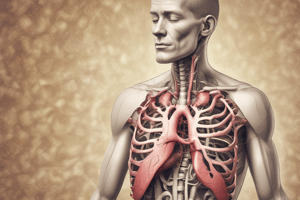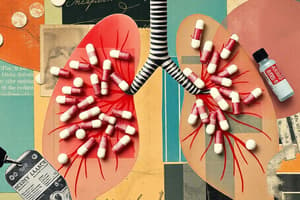Podcast
Questions and Answers
What is the medical term for respiratory obstruction in horses, also known as 'heaves'?
What is the medical term for respiratory obstruction in horses, also known as 'heaves'?
Recurrent airway obstruction (ROA)
Which of the following is NOT an adverse effect of guaifenesin?
Which of the following is NOT an adverse effect of guaifenesin?
- Increased respiratory secretions (correct)
- Muscle relaxation
- Mild decrease in blood pressure
- Increased heart rate
Which of the following is NOT a central acting antitussive?
Which of the following is NOT a central acting antitussive?
- Dextromethorphan (correct)
- Hydrocodone
- Codeine
- Butorphanol
Trimeprazine is often found in combination with prednisolone.
Trimeprazine is often found in combination with prednisolone.
Which of the following is NOT a side effect of methylxanthines?
Which of the following is NOT a side effect of methylxanthines?
What are the two main types of drugs that can be used as bronchodilators?
What are the two main types of drugs that can be used as bronchodilators?
The [BLANK] is considered the master gland of the endocrine system.
The [BLANK] is considered the master gland of the endocrine system.
Which hormone stimulates milk secretion?
Which hormone stimulates milk secretion?
What are the two primary hormones produced by the pancreas that regulate blood glucose levels?
What are the two primary hormones produced by the pancreas that regulate blood glucose levels?
Diabetes mellitus is a common condition in older, obese dogs.
Diabetes mellitus is a common condition in older, obese dogs.
Which type of insulin has the shortest duration of action?
Which type of insulin has the shortest duration of action?
Oral hypoglycemic agents are typically more successful in treating diabetes in cats than in dogs.
Oral hypoglycemic agents are typically more successful in treating diabetes in cats than in dogs.
The presence of [BLANK] in the urine can indicate the breakdown of fats, leading to diabetic ketoacidosis.
The presence of [BLANK] in the urine can indicate the breakdown of fats, leading to diabetic ketoacidosis.
Which of the following is NOT a clinical sign of hypoglycemia?
Which of the following is NOT a clinical sign of hypoglycemia?
The thyroid gland is responsible for producing two key hormones: [BLANK] (T4) and [BLANK] (T3).
The thyroid gland is responsible for producing two key hormones: [BLANK] (T4) and [BLANK] (T3).
What are the three layers of the adrenal cortex?
What are the three layers of the adrenal cortex?
Which of the following is NOT an example of a catecholamine produced by the adrenal medulla?
Which of the following is NOT an example of a catecholamine produced by the adrenal medulla?
Addisons disease is characterized by a deficiency of mineralocorticoids and glucocorticoids.
Addisons disease is characterized by a deficiency of mineralocorticoids and glucocorticoids.
What is the primary drug used to treat Cushing's disease caused by a tumor of the adrenal cortex?
What is the primary drug used to treat Cushing's disease caused by a tumor of the adrenal cortex?
Which of the following is a common sign of hyperadrenocorticism (Cushing's disease)?
Which of the following is a common sign of hyperadrenocorticism (Cushing's disease)?
What is the name of the hormone often used to treat open pyometra in female dogs?
What is the name of the hormone often used to treat open pyometra in female dogs?
Prostaglandins are a type of hormone that are used to treat pyometra in animals.
Prostaglandins are a type of hormone that are used to treat pyometra in animals.
Which of the following is NOT a common sign of upper respiratory tract disease in animals?
Which of the following is NOT a common sign of upper respiratory tract disease in animals?
What is the primary cause of infectious tracheobronchitis in dogs?
What is the primary cause of infectious tracheobronchitis in dogs?
Bovine respiratory disease is also known as "shipping fever."
Bovine respiratory disease is also known as "shipping fever."
What is the most common type of urinary cancer in dogs?
What is the most common type of urinary cancer in dogs?
What is the term used to describe painful or difficult urination?
What is the term used to describe painful or difficult urination?
Which type of diuretic acts on the loop of Henle in the kidney?
Which type of diuretic acts on the loop of Henle in the kidney?
Angiotensin-converting enzyme inhibitors (ACE inhibitors) are primarily used to treat high blood pressure.
Angiotensin-converting enzyme inhibitors (ACE inhibitors) are primarily used to treat high blood pressure.
What is the name of the condition that occurs when muscles are unable to contract properly due to a disruption in the transmission of nerve impulses?
What is the name of the condition that occurs when muscles are unable to contract properly due to a disruption in the transmission of nerve impulses?
Glucocorticoids are a type of steroid that can be used to treat muscle pain and inflammation.
Glucocorticoids are a type of steroid that can be used to treat muscle pain and inflammation.
Which of the following is NOT a common cause of vomiting in animals?
Which of the following is NOT a common cause of vomiting in animals?
What is the name of the drug that works by blocking dopamine receptors in the chemoreceptor trigger zone, reducing the stimulation to vomit?
What is the name of the drug that works by blocking dopamine receptors in the chemoreceptor trigger zone, reducing the stimulation to vomit?
Metoclopramide is contraindicated for treatment of vomiting in cases of GI obstructions.
Metoclopramide is contraindicated for treatment of vomiting in cases of GI obstructions.
Maropitant is a powerful antiemetic that works by blocking the [BLANK] receptors in the brain.
Maropitant is a powerful antiemetic that works by blocking the [BLANK] receptors in the brain.
Which of the following is NOT an example of an anti-ulcer drug?
Which of the following is NOT an example of an anti-ulcer drug?
Prokinetic agents are medications that enhance the motility of the gastrointestinal tract, potentially speeding up the movement of food through the digestive system.
Prokinetic agents are medications that enhance the motility of the gastrointestinal tract, potentially speeding up the movement of food through the digestive system.
Which of the following is NOT a common example of a pancreatic enzyme supplement?
Which of the following is NOT a common example of a pancreatic enzyme supplement?
Ghrelin receptor agonists are substances that can stimulate [BLANK] in dogs and cats.
Ghrelin receptor agonists are substances that can stimulate [BLANK] in dogs and cats.
Tetracyclic antidepressants can stimulate appetite in dogs by antagonizing alpha-2 receptors.
Tetracyclic antidepressants can stimulate appetite in dogs by antagonizing alpha-2 receptors.
Serotonin antagonist antihistamines can promote appetite by inhibiting the [BLANK] receptors, which control satiety.
Serotonin antagonist antihistamines can promote appetite by inhibiting the [BLANK] receptors, which control satiety.
Flashcards are hidden until you start studying
Study Notes
Respiratory System Drugs
- Respiration is the exchange of gases between the atmosphere and the body's cells.
- Ventilation is the process of bringing fresh air into the body.
- Upper respiratory tract includes the nares, nasal cavity, pharynx, and larynx.
- The upper respiratory tract is lined with epithelial cells containing cilia.
- Cough receptors are primarily located in the pharynx and trachea.
- Diseases of the upper respiratory tract include congestion, sneezing, and coughs.
- The lower respiratory tract includes the trachea, bronchi, bronchioles, and alveoli.
- Bronchioles have smooth muscle, with sympathetic stimulation causing relaxation (bronchodilation) and parasympathetic stimulation causing contraction (bronchoconstriction).
- Alveoli produce surfactant to keep them open, and diseases include asthma, bronchitis, pneumonia, and recurrent airway obstruction (ROA), including heaves in horses.
- Expectorants increase the flow of respiratory secretions, making material easier to cough up.
- Guaifenesin increases respiratory secretions and is used as a muscle relaxant in horses (triple-drip).
- Adverse effects include mild decreases in blood pressure and increased heart rate.
Mucolytics
- Mucolytics decrease the viscosity of respiratory secretions.
- Acetylcysteine is used to treat acetaminophen toxicity in cats and prevent corneal damage in horses.
- Possible side effects include vomiting and hives (rarely), and chest tightness/irritation in the lower respiratory tract.
Antitussives
- Antitussives suppress coughs, but productive coughs are not always suppressed.
- Anti-tussives can act centrally (on brain stem centers) or locally (on mucosal linings).
- Opioids, Butorphanol, Hydrocodone, Codeine are centrally acting antitussives and can cause respiratory depression.
- Dextromethorphan is an OTC cough medication chemically similar to cocaine.
Decongestants
- Decongestants reduce nasal swelling.
- Many come in sprays, liquids, or tabs (PO).
- Decongestants are used to reduce nasal swelling by decreasing inflammation of the mucosal lining or reducing swelling, reducing congestion or swelling.
- Phenylephrine and pseudoephedrine are used; the latter may be combined with antihistamines.
Bronchodilators
- Bronchodilators widen the airways counteracting bronchoconstriction, produced by stimulating the sympathetic nervous system or by suppressing the parasympathetic nervous system.
- Examples of Bronchodilators include: Epinephrine, Isoproterenol, Terbutaline, and Albuterol.
- Beta-2-adrenergic agonists stimulate the Beta-2 receptors in the sympathetic nervous system, involved in bronchodilation and mast cell stabilization.
- Methylxanthines (Aminophylline, Theophylline) also have bronchodilating effects but also inhibit an enzyme in smooth muscle.
- Adverse effects include nausea, vomiting, CNS stimulation (Increased heart rate).
- Antihistamines bind with H1 receptors to cause bronchodilation, decreased HR, vasodilation, CNS sedation, and inhibit inflammation response.
- Ex: Diphenhydramine & Chlorpheniramine.
- The side effects for antihistamines include CNS depression and anticholinergic effects, such as dry mouth & urinary retention.
Respiratory Stimulants
- Respiratory stimulants stimulate respiration, such as Doxapram usually used to simulate respiration in dystocia or C-sections.
Respiratory Diseases
- Asthma is a chronic inflammatory disease of the lower airways in cats, triggered by inhaled allergens, resulting in smooth muscle contraction.
- Clinical signs include wheezing, dry cough, open-mouth breathing, and dyspnea (labored breathing).
- Treatment includes Glucocorticoids, bronchodilators.
- ROA (Recurrent Airway Obstruction, "heaves" in horses)- treated with medications and management practices, like keeping horses outdoors and managing dust levels.
Hormonal and Reproductive Drugs
- Hormones are chemical messengers produced by glands, regulating cellular activity.
- The main glands include the pituitary, thyroid, parathyroid, adrenal, pancreas, thymus, pineal, and gonads.
- Endocrine glands respond to feedback from the hypothalamus and other endocrine glands. These feedback loops can be negative or positive.
- Exogenous hormones are supplemental or replacement hormone therapy.
- Hormones produced in excess need to be decreased through the use of drugs.
- Example includes using drugs to decrease endogenous hormone production or activity, such as in the case of master gland control via the pituitary gland.
Blood Glucose Regulation
- The pancreas secretes insulin (promotes glucose uptake) and glucagon (increases glucose levels by breaking down glycogen).
- Hypoglycemia is a low blood glucose condition managed to help avoid hypoglycemia, which happens when the body does not produce enough glucose or when the body uses too much glucose.
- Insulin (if administered) is used to decrease glucose levels.
- Drugs can be used to simulate pancreatic beta cell production and increase secretions, thereby stimulating insulin production.
- SGL2 inhibitors prevent glucose reabsorption in the kidneys, enabling urination of excess glucose.
- Examples of hypoglycemic drugs include glipizide, and those drugs are used to treat animal disorders such as diabetes mellitus.
Antidiuretic Hormone (ADH)
- ADH promotes water retention by concentrating urine due to insufficient water release, which is the cause of diabetes insipidus.
- Oxytocin is used as adjunct therapy to stimulate uterine contractions to expel placenta, and stimulate milk letdown.
Studying That Suits You
Use AI to generate personalized quizzes and flashcards to suit your learning preferences.





